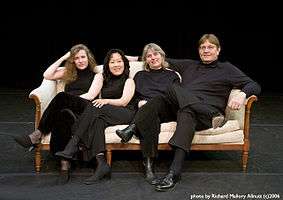Audubon Quartet
| Audubon Quartet | |
|---|---|
|
The Quartet in 2006, left to right: Jewett, Takayama, Lederer, and Shaw | |
| Background information | |
| Genres | classical |
| Years active | 1974–2011 |
| Website | audubon4tet.com |
| Members |
[Final quartet]
|
The Audubon Quartet (1974-2011) was an American string quartet based in southwest Virginia that was particularly successful in international competition in the late 1970s. Founded by cellist Tom Shaw, it featured violist Doris Lederer and violinist Akemi Takayama, with other musicians in its history including violinists Dennis Cleveland, David Ehrlich, and Ellen Jewett. It was the first American string quartet to win major acclaim at international string quartet competitions, and recorded a number of albums, and played for President Jimmy Carter. The Audubon Quartet played its final performance in 2011.
Description
The Audubon Quartet was a string quartet based in Winchester, Virginia, that at the time of its dissolution included cellist Tom Shaw, violist Doris Lederer, and violinists Ellen Jewett and Akemi Takayama. At that time, it served as quartet in residence at the Shenandoah Conservatory at Shenandoah University, in Winchester, Virginia.
History
The quartet was founded by cellist Tom Shaw in 1974.[1] Its early composition was Shaw on cello, Dennis Cleveland or Laurence Shapiro or Sharon Smith Polifrone on violin, and Doris Lederer on viola.[2][3] The quartet played for President Jimmy Carter,[1] served as the quartet in residence at Virginia Tech during the 1980s,[1] and subsequently in the same capacity at the Shenandoah Conservatory at Shenandoah University.
Like other tightly knit string quartets whose quarrels have become matter of the public record (e.g., the Budapest, Tokyo, and Guarneri),[1] the Audubon Quartet entered into a "severe period of time of disagreements and arguments" having to do with "money… balance issues, artistic differences" as described by founder Tom Shaw to NPR, leading to turmoil that ended with separation of violinist David Ehrlich in 2000, and a legal case in the State of Pennsylvania where the quartet was incorporated as a not-for-profit.[1]
The Audubon Quartet later added a new violinist,[1] and continued playing until 2011. Their last decade was an "harmonious existence" and their decision to disband as "mutual and amicable," as described by the group at the time to the The Daily Chautauquan.[4] Their closing concert featured the Viola Quintet in E Flat Major, Op. 97 and five of Dvořák’s “Cypresses”.[4]
Members
At time of dissolution
The violins of the quartet at the time the group ceased performing were Akemi Takayama[1] and Ellen Jewett. Tom Shaw was on cello, and Doris Lederer was on viola.[1]
Earlier
- Dennis Cleveland served as the quartet's first violin during a critical period through the 1970s, leaving the group to take other concertmaster and related positions.[3] Violinists after Cleveland but before David Ehrlich (see following) included Laurence Shapiro and Sharon Smith Polifrone.[2] David Ehrlich was a violinist in the group from ca. 1984-2000.[1]
Awards and recognition
The Audubon Quartet was the first American string quartet to win a first prize at an international string quartet competition. The quartet enjoyed international recognition,[1] with top prizes at competitions that included:
- The International String Quartet Competition in Evian, France (1977)[5]
- The String Quartet Competition at the Festival Villa Lobos in Rio de Janeiro, Brazil (1977)[5]
- The International String Quartet Competition in Portsmouth, England (1979)[6]
Selected discography and reviews
The group recorded a number of long playing albums.[1]
See also
References
- 1 2 3 4 5 6 7 8 9 10 11 Rose, Joel; with Shaw, Tom; Steinhardt, Arnold; Takayama, Akemi; Alpern, David; Brune, Ron & Lederer, Doris (December 9, 2005). "Audubon String Quartet Lawsuit Mixes Music, Business" (radio interview and transcript). NPR. Retrieved March 4, 2017.
- 1 2 Holland, Bernard (April 4, 1984). "Music: Audubon Quartet at Tully Hall" (review). The New York Times. Retrieved March 4, 2017.
- 1 2 SS Staff (November 9, 1987). "Cleveland is Concertmaster". Standard-Speaker [SS]. Hazleton, PA: p. 25. Retrieved March 4, 2017. (Subscription required (help)).
- 1 2 Hutchison, Lauren (August 8, 2011). "Audubon Quartet to Perform Final Concert". The Daily Chautauquan. Retrieved March 4, 2017.
- 1 2 "Lois Scott Management Inc.". 28 September 2007. Archived from the original on 28 September 2007. Retrieved 4 March 2017.
- ↑ "London String Quartet Foundation". 16 August 2007. Archived from the original on 16 August 2007. Retrieved 4 March 2017.
External links
Further reading
- Holland, Bernard (April 4, 1984). "Music: Audubon Quartet at Tully Hall" (review). The New York Times. Retrieved March 4, 2017.
- Ravas, Tammy (2004). Peter Schickele: A Bio-bibliography. Bio-bibliographies in music, Issue 92. Westport, CT: ABC-CLIO/Greenwood. ISBN 0313320705. ISSN 0742-6968. Retrieved March 3, 2017.
- Rose, Joel; with Shaw, Tom; Steinhardt, Arnold; Takayama, Akemi; Alpern, David; Brune, Ron & Lederer, Doris (December 9, 2005). "Audubon String Quartet Lawsuit Mixes Music, Business" (radio interview and transcript). NPR. Retrieved March 4, 2017.
